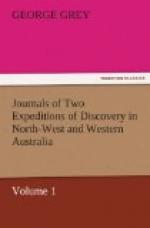A party of us this day walked to Hanover Bay for the purpose of making some observations on the sandy beach there, after which we went over to Prince Regent’s River, near Munster Water. The country until near the bank of the river at this point was of the same sandy nature as that about the beach: there however it improves; and from the circumstance of my finding a regular haunt of the natives I feel sure that there is plenty of fresh water in the neighbourhood. This place of their sojourn resembled one before described, and many others I had seen. An extensive circle was formed by laying a large flat stone upon the ground, and on each of these a smaller one; between the two they evidently crushed the shellfish and nuts which formed their food. Near some of the stones were laid huge shells for the purpose of drinking from; and in the centre of the circle were the marks of frequent fires. We heard the natives calling to one another in the woods, but saw none of them; and in the evening returned to our encampment.
Isthmus near Hanover bay.
January 6.
I made an excursion this day for the purpose of examining the land lying between Port George the Fourth and Hanover Bay: it consists of a low neck which connects the peninsula terminating in High Bluff Point with the main. Thus it is bounded on two sides by the sea, and on the other two by rocky hills which are perfectly precipitous, both towards the main and the peninsula; but a natural terrace runs along under the cliff in the direction of Camden Sound, which I believe would form a good road to that harbour. The tract thus enclosed appears to be very fertile. Porphyry and basalt are the common rocks. The soil is rich vegetable mould, mixed with gravel and covered with the most luxuriant grass. The trees were in general small. We only found three springs here; these however were sufficient to prove that it was well supplied in this respect. A species of plant was observed here, which in appearance and smell exactly resembled the jasmine of England: and it would be difficult to give any adequate impression of the singular sensation of pleasure derived from the sight of this simple emblem of home. Here were regular beaten tracks of the natives, as completely pathways as those we find in England leading from a village to a farmhouse.
Hill of shells.
Near the sea we also came upon a complete hill of broken shells, which it must have taken some centuries to form, for it covered nearly, if not quite, half an acre of ground, and in some places was ten feet high: it was situated just over a bed of cockles, and was evidently formed from the remains of native feasts, as their fireplaces, and the last small heaps of shells were visible on the summit of the hill.* This neck of land is undoubtedly of the first importance; for, lying as it does between Port George the Fourth and Hanover Bay, it commands two excellent harbours, and its soil is moreover highly fertile. I conceive that a point nearer Camden Bay would be of greater consequence to the mother country; but, after such a spot, this neck of land is the most important position on the North-west coast of Australia.




